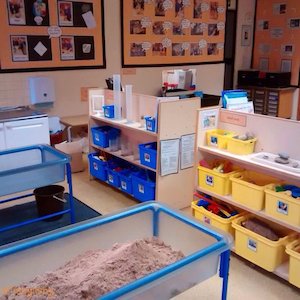What’s in your… sand area?
Add to My Folder
In this series, Fe Luton explores the ways in which you can set up and run areas of continuous provision. Ideas for organisation, resources and planning are explored.

How should my sand area be arranged?
While we often contemplate our sand and water areas together, it is important to remember that they are completely different and need to be planned for and developed separately.
Sand play is a platform for many aspects of the Early Years curriculum and of child development. It promotes gross and fine motor skills, as well as hand-eye coordination and helps develop social skills, problem solving and communication. Children develop their imagination, mathematical skills, language skills and investigative skills. Consequently, it is hugely important to target your sand area in a way that promotes specific skills based on child-specific objectives. Sand can easily become overwhelmed with resources or stagnant with under resourcing or the same old resources used day in day out.
Consider the following when organising your sand area:
- Try to ensure that children can explore the sand area without any expectation that there is a ‘correct’ approach to its use. The main basic skill you are enabling is the exploration of sand and its nature
- We don’t often need to coax children into the sand area as they are generally drawn to it through sensory fascination. Sometimes this can result in your sand becoming a ‘busy’ area with bottlenecks of children wanting to get involved. As such it is an area that needs access management. Find a way that works for you and your children, such as having:
- five wrist bands available for five children to use – children will quickly develop the art of negotiation to gain a wristband
- a specific day or session that they can use it, although this can be quite restrictive
- a maximum time limit for being in the area (though long enough for meaningful exploration and concept development)
- a waiting list!
- plenty of sand play (e.g. inside and outside sand play for five children at each station enables a third of the class at a time to be engaged with it)
- Ensure resources are easily accessible and close by so that children are not trailing through the setting covered in sand
- Don’t forget to include resources that will develop both gross and fine motor skills and hand-eye coordination – having dust pans and brushes for cleaning up also develops motor skills!
- Consider the importance of language development in sand play. Not only can it support the development of cooperative language as well as learning to negotiate, but specialist words for equipment, observational language, positional language and story narrative can also be developed and expanded through a carefully organised sand area
- Consider safety issues. Don’t use things that might easily break or that have sharp edges. Consider the potential dangers of straws and rules about sand being thrown
- Try to have equipment stored in slotted trays with a sand-catching tray or regular sweep up to ensure that resources dry properly. Children should also be able to self-select as a result
- Encourage children to suggest items they would like included in the sand area and try to change and modify resources to keep children interested, inspired and excited about the area – it is very easy for sand to stagnate and become a low level learning experience
- Consider the use of natural, outdoor resources in outdoor sand play – adding in twigs or stones, for example
- Remember that sand should be available dry and wet – these are two very different experiences for children and develop different opportunities and skills
- Sand provides opportunities for storytelling, small world imaginative play, science investigations, experimental play and mark-making. We need to ensure that we enable these opportunities through the set-up of the area and the resources available
- Remember to include resources made from a variety of materials (not just plastic!), plus more open-ended resources such as stones, funnels, and boxes
Already a member? Sign in below.
Published 16 March 2018
Reviews
Rated 4/5 from 1 rating
You need to be signed in to place a review.
